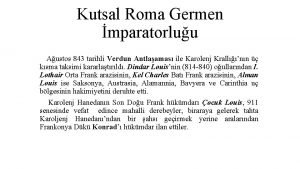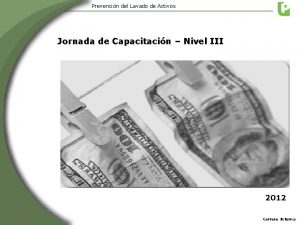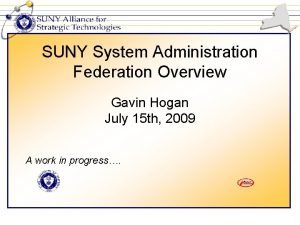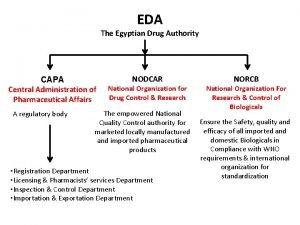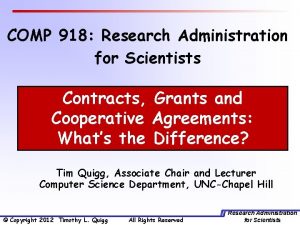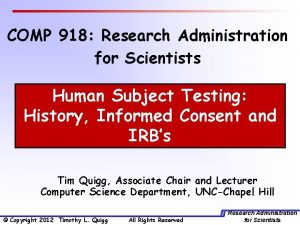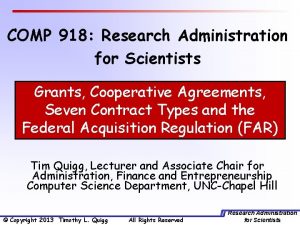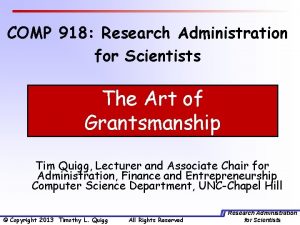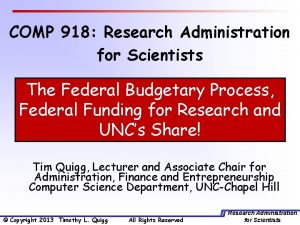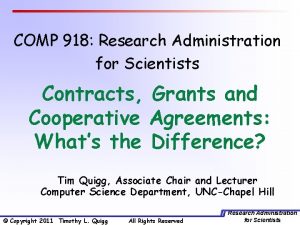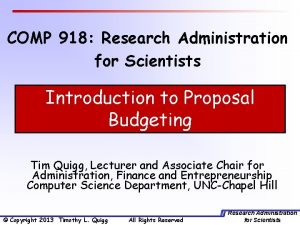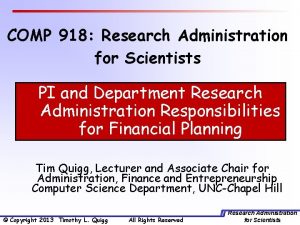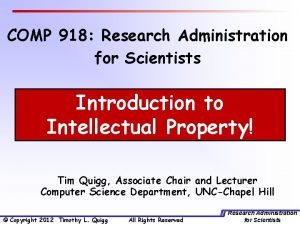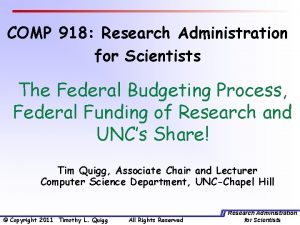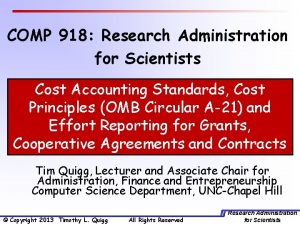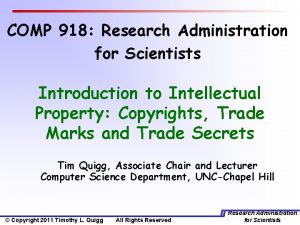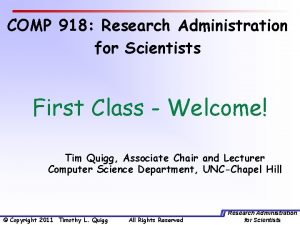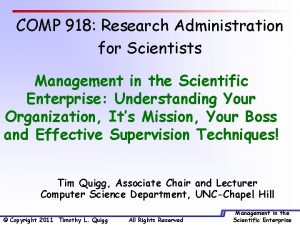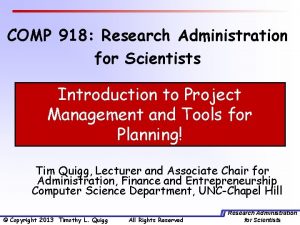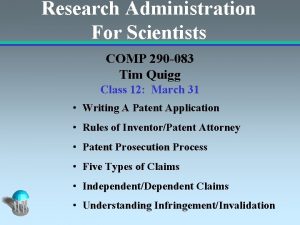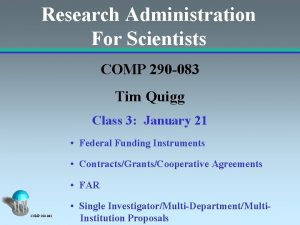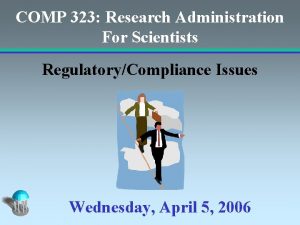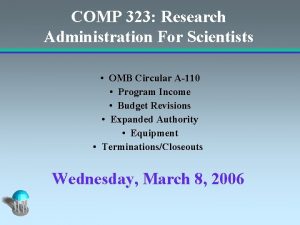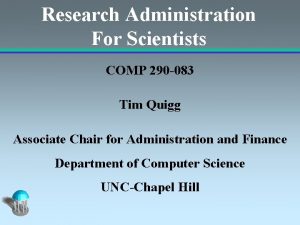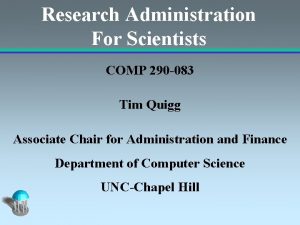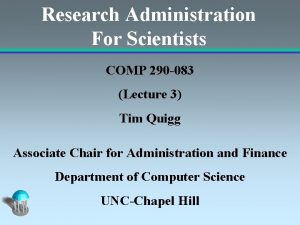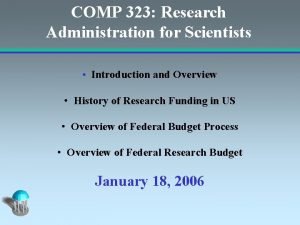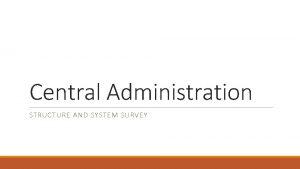COMP 918 Research Administration for Scientists Central Research


















































- Slides: 50

COMP 918: Research Administration for Scientists Central Research Administration Tasks and Responsibilities: UNC-Chapel Hill Case Study! Tim Quigg, Lecturer and Associate Chair for Administration, Finance and Entrepreneurship Computer Science Department, UNC-Chapel Hill © Copyright 2013 Timothy L. Quigg All Rights Reserved Research Administration for Scientists

Remember… § § Awards are made to an organization in the name of a Principal Investigator. The PI has primary responsibility for project performance and the university has rather complex compliance responsibilities. • • • As the legal recipient/contractor, the university has the ultimate legal burden for compliance. Under “Expanded Authority”, universities are granted authority to act on behalf of the Government in certain areas, e. g. , NCEs. System must be independent, compliant with federal requirements and subject to audit. Research Administration for Scientists

Remember… § § Awards are made to an organization in the name of a Principal Investigator. The PI has primary responsibility for project performance and the university has rather complex compliance responsibilities. • • • As the legal recipient/contractor, the university has the ultimate legal burden for compliance. University SROs must Under “Expanded Authority”, universities are careful attention grantedpay authority to act on behalf ofto the Government in certain areas, e. g. , NCEs. rules and compliance! System must be independent, compliant with federal requirements and subject to audit. Research Administration for Scientists

But Also Remember… § § Sponsored research funding is an important metric in determining a university’s position in the national rankings. And like it or not, rankings matter – higher ranked universities are better positioned to attract the best faculty and students. The “rich are getting richer” – the top 25 schools get 35% of all federal research funding, up from 31% just 4 years ago. And this trend toward consolidation of funding at the “top schools” is continuing. Research Administration for Scientists

§ § As previously stated, sponsored research funding has become a major funding source for many universities including UNC-Chapel Hill. Many jobs, including those of the SRO staff, are dependent upon the on-going receipt of F&A funds derived from sponsored research. Job Description for Director of Cost Analysis Position “The Director’s role includes a combination of management, administrative and senior level cost accounting responsibilities that must be effectively performed to ensure overhead receipts continue at appropriate levels. ” Research Administration for Scientists

§ § As previously stated, sponsored research funding has become a major funding source for many universities including UNC-Chapel Hill. Many jobs, including those of the SRO staff, are dependent upon the on-going receipt of F&A funds derived from sponsored research. Universities have a vested interest in “growing” their sponsored research funding! Research Administration for Scientists

Tools Universities Use to Attract Research Funding Seed Grants Large Retention Packages Grant Writing Assistance New Buildings & Labs Sponsored Research $$$$ Raiding “Stars” from other Universities Interdisciplinary Programs Research Administration for Scientists

For many universities, it’s just math! As state funding and investment income have fallen (ongoing but excelerated during the Recession) Universities have focused on expanding their sponsored research funding! And as their dependency on F&A receipts grows … … the potential for conflict between compliance and funding growth increases! Research Administration for Scientists

Here’s the “Rub”! It’s not an “either - or” situation. The reality for most universities is that they must do both: – Pursue strategies for expanding their research budgets (self-interest) and – Maintain strict compliance standards (stay out of trouble) And they must do both well! Research Administration for Scientists

Balancing? Or Something Else? Note: It’s not just a matter of determining how to “balance” the two interests because balance suggests compromise. The challenge is much more difficult because to be successful, the modern university must excel at both! Many approaches have been tried, but ultimately all approaches must involve the university’s organizational structure and its budget. Research Administration for Scientists

Organization and Budget • • Where does each function reside within the university? Is it assigned to a high profile office (close to the Chancellor) or “buried” in the bureaucracy? What is the title for the head of each function? Are the titles comparable? How much money is allocated to each function? Remember – The best way to determine what any organization truly values is to look at their budget! Research Administration for Scientists

Three Approaches for Managing this “Dual Role” 1. Separate the functions and assign them to two different offices: compliance in one and faculty assistance in another. 2. Place both functions in the same office but assign them to different staff. 3. Place both functions in the same office and assign them to the same staff. Encourage a culture where compliance is viewed as just another aspect of faculty “assistance/help. ” Research Administration for Scientists

1. Separate the functions and assign them to two different offices: compliance in one and faculty assistance in another. § This is the most common model used by universities. § Primary responsibility for compliance is assigned to the SRO (although it is increasingly common for universities to also have a separate Office of Institutional Compliance). More on this later! § Faculty assistance may be assigned to one or more office, e. g. , Proposal Development Office, Vice Chancellor for Research and in departments/schools. § Advantage – Clarity of roles for offices/staff. § Disadvantage – “Good guys - bad guys” competition and difficulties coordinating the efforts of both. Research Administration for Scientists

2. Place both functions in the same office but assign them to different staff. § Since individual staff are not asked to perform both compliance tasks and assistance tasks, this approach maintains clarity of roles for staff. § Locating both functions in the same office under a the same supervisor suggests the university assigns equal importance to each. § One supervisor with duel responsibilities has a better opportunity to “coordinate” the two functions than two separate supervisors. § Disadvantage – If strict compliance is perceived as a potential barrier to increasing funding, the supervisor may face difficult choices and potential conflicts! Research Administration for Scientists

3. Place both functions in the same office and assign them to the same staff. Encourage a culture where compliance is viewed as just another aspect of faculty “assistance/help. ” § Staff are empowered to make sophisticated judgments requiring them to maintain compliance while simultaneously enhancing PI competitiveness through the provision of appropriate training, problem -solving and support. § Work loads (campus units/staff) must be kept as low as possible to allow this level of personalized service to PIs to be offered. § This approach requires highly trained senior staff to be successful. Research Administration for Scientists

Two Approaches to Organizing SRO Offices “Organize Around the Work” or “Organize Around the Clients” Research Administration for Scientists

Organize SRO Offices “Around the Work” § § Pre-Award/Post-Award – “Pre” includes proposal preparation/submission and “Post” includes management of awards from NOA through closeout. This is the most common organizational structure used by SROs. Cradle-to-Grave – Staff teams handle all aspects of awards from initial proposal preparation through final closeout. This structure is “catching on” and is being used more frequently by SROs. Research Administration for Scientists

Organize SRO Offices “Around the Work” Pre-Award/Post-Award § Advantages • Staff specialization - by doing fewer things staff become experts in what they do. Some believe this leads to greater operational efficiency. • This organizational structure is preferable for SROs populated with many lower classified positions. Research Administration for Scientists

Organize SRO Offices “Around the Work” Pre-Award/Post-Award § Advantages • Staff specialization - by doing fewer things staff become experts in what they do. Some believe this leads to greater operational efficiency. • This organizational structure is preferable for SROs populated with many lower classified positions. What does efficiency mean? Research Administration for Scientists

Efficiency - Effectiveness It’s A Balancing Act! Efficiency – Producing the greatest quantity of work for each unit of resource expended or producing a unit of work for the smallest possible expenditure of resources. Effectiveness – Successfully accomplishing the goals/objectives of the organization. Fulfilling Its Mission! Research Administration for Scientists

Organize SRO Offices “Around the Work” § Pre-Award/Post-Award Advantages • Staff specialization - by doing fewer things staff become experts, thus increasing efficiency. • This organizational structure is preferable for SROs populated with many lower classified positions. § Pre-Award/Post-Award Disadvantages • Transactions are processed along an “assembly line” with multiple “hand-offs” which potentially create: • • Confusion and/or error at each handoff and a Lack of “ownership for the whole!” Research Administration for Scientists

Organize SRO Offices “Around the Work” § Cradle-to-Grave Advantages • SRO staff are responsible for “the whole” (full integration of all aspects of award management). • Fewer hand-offs minimize the chance for error. • Potential for developing close working relationships between SRO staff and PIs/Depts. • As SRO staff are accepted as an integral “part of the team”, their morale goes up. § Cradle-to-Grave Disadvantages • The need for many highly classified (costly) staff. Research Administration for Scientists

Organization of SRO Offices “Organize Around the Clients” Who are the Clients? Funding Agencies or Campus Departments/PIs Research Administration for Scientists

Organize SRO Offices “Around the Clients” § § By Funding Agency - SRO staff become experts in the rules of a particular agency (NSF, NIH) and they are able to develop close working relationships with agency staff. By Campus Unit - SRO staff must become familiar with the rules/policies of multiple agencies. But by working closely with specific department faculty/staff on many issues, they are able to develop close working relationships with the departments they serve. Research Administration for Scientists

Organization of SRO Offices Special Combinations § § § Organize SRO using the traditional pre-award/postaward structure, but then create teams within each to support campus departments. Organize SRO into teams assigned to support specific campus departments, but with specialists housed within or at least available to each team. Assign industry-funded awards (one-off and intellectual property intensive), international projects (complex currency and legal issues) and/or federal contracts (FAR) to specialists or specialist teams. Research Administration for Scientists

UNC-CH Case Study: Background ü ü Primary responsibility for both compliance and operations was assigned to the SRO, i. e. , the Office of Sponsored Research (OSR), headed by an Associate Vice-Chancellor reporting to the Vice Chancellor for Research. OSR used the traditional Pre-Award/Post-Award organization structure with strong managers over each of the two units. A long-standing rivalry existed between the two units due in part because Pre-Award had higher classified positions (Contract Specialists) often filled by Master’s level staff and while Post-Award had more positions, they were lower classified clerical positions often filled by high school graduates. Research Administration for Scientists

UNC-CH Case Study: Background ü ü ü A separate Office of Proposal Development (OPD) also reported to the VCR with primary responsibility for assisting PIs prepare major multi-disciplinary proposals. Faculty assistance with proposal development was decentralized resulting in uneven availability of these services, e. g. , the Medical School could afford to hire staff to provide assistance while many departments within the College could not. Some believed OSR had a faculty assistance role, but responsibilities at the staff level were not clearly defined. Research Administration for Scientists

UNC-CH Case Study: Background ü ü ü OSR (along with many of the other “business units” at UNC) was chronically understaffed when compared with peer institutions. OSR was located off-campus (first on West Franklin Street and later at the Administrative Office Building on MLK Boulevard). Many believed this contributed to the perception of an office “disconnected” from campus. Emphasis at OSR was on operations (transaction processing). The office was headed by a professional Research Administrator, but otherwise there were few high level research administrators available to assist campus units with complex issues. Research Administration for Scientists

UNC-CH Case Study: Background ü ü The quantity of sponsored research expanded rapidly during the period from 1990 through 2005 with little consideration by UNC management for building appropriate capacity within the OSR. By 2005, the strain on the system was obvious and because faculty complaints were so pervasive, the task of “fixing OSR” became a hot topic at South Building. Research Administration for Scientists

UNC-CH Case Study: Background ü ü View from within OSR - We are working as hard as we can and can never keep up with the demand. We need to hire more people. And by the way, everybody hates us! View from Campus – Good faculty are leaving UNC because of the poor quality of support provided by OSR. It takes far too long to get answers to simple questions, phone calls aren’t being returned and simple transactions (getting an account number for a new award) take far too long. Evidence of complaints from funding agencies was also growing. Both were correct! Research Administration for Scientists

UNC-CH Case Study Crisis Point Reached in 2006! The Vice Chancellor for Research appointed an OSR review committee! Broad mandate for reviewing operations and making recommendations for improvement. ü 15 members - 11 from campus, 4 from OSR. ü Met weekly for 14 months. ü Sought input through public hearings, group meetings, interviews with key faculty. ü Interim recommendations and final report. ü Ground Rule: Discussion of individual staff performance was off limits! ü Research Administration for Scientists

Guiding Principle! “UNC-Chapel Hill’s world class faculty research enterprise deserves and requires a world class administrative support system!” Research Administration for Scientists

Statement of Problem (Initial Findings) ü ü Excessive processing delays - account numbers, budget modifications, project extensions. Inadequate communication between OSR and campus – problems with both high level communication and routine communication (just getting calls returned). Inadequate communication between OSR units, especially between pre-award and post-award. Inconsistent policy interpretation within OSR staff. Research Administration for Scientists

Six Sequential Topics for Review ü ü ü Organizational structure Use of automation Policy, procedures, workflow, priorities and duplication of effort Sharing responsibility/authority with campus sub-units Staff skills/experience/education levels Number of staff Research Administration for Scientists

Research Dollars v. Staffing Research Administration for Scientists

No “Silver Bullet” Solution! Problems existed in all areas! ü Each of the six topics required careful study. ü Topics were not discrete and many were inter-related. ü Approach: Analyze each topic sequentially beginning with organizational structure. ü Assumption: It took many years to create this “mess”, everything won’t be fixed overnight! ü Research Administration for Scientists

Pre-Award/Post-Award Organizational Structure Associate VC and Director

Pre-Award/Post-Award Organizational Structure Campus Associate VC and Director Proposal processing Sponsor 1 Sponsor N

Pre-Award/Post-Award Organizational Structure Campus Questions Associate VC and Director Sponsor 1 P O T S • Numbe r • Budget • Review Negotiate • Sign • Prepare Summary Incoming Awards to Proposals Trump Award Establishments Account Establishment Sponsor N

Topic 1 – Organizational Structure § Old Organization Chart § § No single person was responsible for important end products. Competing priorities: external deadlines trump internal needs. Confusion at pre-award/postaward hand-off. Multiple hand-offs of a single transaction create inefficiencies and errors. Sponsor-centric organization was convenient for OSR but bad for campus, and it did not promote a commitment to quality customer service!

Associate VC & Director Proposal Management Director Award Management Director Reporting & Cash Management Director Cash Management Specialist Proposal Specialist 1 … Proposal Specialist N Award Manager 1 … Award Manager N Reporting Unit Manager … Reporting Unit Manager (Campus Specific) (Sponsor Specific) • Major Project Pre-Proposal Assistance • Post-Proposal Agency Communications • Reporting/Invoicing • Proposal Review • Letter of Guarantee • Agency Communications until proposal is accepted • Account Establishment • Bi-Lateral Award Negotiation/Signature • Subcontracts/Sub-accounts (Sponsor Specific) • Award Maintenance • Pre-Audit • Accounts Receivable • Closeout

Topic 1 – Organizational Structure § New Organization Chart § § Each primary “product” (proposals and awards) is assigned to a different person/group, thus eliminating conflicting priorities. Responsibility is clarified – a proposal is transferred to Award Management when it is “accepted by the sponsor as complete. ” Inefficiencies and errors are minimized by replacing “assembly line” with “single touch” system. OHIO – Only handle it once!

Topic 1 – Organizational Structure § New Organization Chart § § Each primary “product” (proposals and awards) is assigned to a different person/group, thus eliminating conflicting priorities. Responsibility is clarified – a proposal is transferred to Award Management when it is “accepted by the sponsor as complete. ” Inefficiencies and errors are minimized by replacing “assembly line” with “single touch” system. Organizing the Award Management Unit to serve Campus Units improved Customer Service!

Topic 2 – Use of Automation q RAMSe. S – Proposal Administration System • Transparency - Share as much detail as possible with campus, e. g. , proposal status and grant salary access for faculty outside PI’s department on a need-to-know-basis. • Increase functionality, e. g. , add a subcontract module that allows campus units to enter key information such as budget, Scope of Work. q Electronic Sponsor Invoicing System The current manual process was labor-intensive and did not take advantage of “repeat monthly data entries. ” • Implement an automated with review system. •

Topic 3 – Policy, Procedures, Workflow, Priorities & Effort Duplication q q Eliminate duplicate review of transactions by multiple central offices, e. g. , if travel forms are approved by the travel accounting office, OSR should accept without further review. If the quality of review is a problem, the two Directors should resolve through training or other action. Simplify budget set-up by requiring only what the agency requires – use the practice of loading all dollars in the revenue line and creating “budgets” as expenditures.

Topic 3 – Policy, Procedures, Workflow, Priorities & Effort Duplication q q q Streamline contracting/subcontracting by prenegotiating terms and conditions with “repeat customers. ” Enable the use of electronic signatures when ever possible, e. g. , effort reporting and final closeout documents (invention report). Publish, distribute and maintain a current policy manual with clearly defined responsibilities for each level of the organization.

Topic 4 – Delegate Authority to Campus Units for Selected OSR Tasks! Not all departments will be able to (or will want to) assume additional responsibility, but UNC’s policy should be to encourage building department-level capacity where ever possible. ü ü Paradigm Switch – Use training as a strategic tool for developing and verifying individual capability on campus to “do work” previously reserved for OSR staff! The Research administrator certification program: training-testing-mentoring-delegationmonitoring!

Topic 4 – Delegate Authority to Campus Units for Selected OSR Tasks! Not all departments will be able to (or will want to) assume additional responsibility, but UNC’s policy should be to encourage building department-level capacity where ever possible. ü ü Implement formal delegation agreements between OSR and the department that clearly define duties, responsibilities and renewal dates! The Goal in a tight budget environment is to: Add qualified “staff cycles” without increasing OSR budget.

Topic 5 – Staff Skills/Education q q q Observation: The distribution of staff positions was unbalanced with too many clerks and too few senior “problem solvers. ” Average staff salary - UNC was $15 K below peer institutions. Dual strategy for transition: § Ongoing training/enrichment for existing staff. § Use attrition to rewrite job descriptions to elevate education and experience requirements and position classification (salary) for new staff.

Topic 6 – Number of Staff q q Based on data from peer institutions concerning average positions per $100 million of research funding, OSR had nine too few positions. Targeted additions q Add positions in accounting and award negotiation (require applicants to have experience with industry sponsored and/or international projects). q Create a Deputy Director for Operations position. q “Beef-up” information technology capability. q Phase-in additional positions over two years.
 918 saksonya dükü
918 saksonya dükü Decreto 918/2012
Decreto 918/2012 Pet 3351 ucf
Pet 3351 ucf Cdpa tu
Cdpa tu Suny central administration
Suny central administration Central administration of pharmaceutical affairs (capa)
Central administration of pharmaceutical affairs (capa) Fspos
Fspos Typiska novell drag
Typiska novell drag Nationell inriktning för artificiell intelligens
Nationell inriktning för artificiell intelligens Returpilarna
Returpilarna Varför kallas perioden 1918-1939 för mellankrigstiden?
Varför kallas perioden 1918-1939 för mellankrigstiden? En lathund för arbete med kontinuitetshantering
En lathund för arbete med kontinuitetshantering Särskild löneskatt för pensionskostnader
Särskild löneskatt för pensionskostnader Tidböcker
Tidböcker Sura för anatom
Sura för anatom Förklara densitet för barn
Förklara densitet för barn Datorkunskap för nybörjare
Datorkunskap för nybörjare Tack för att ni lyssnade bild
Tack för att ni lyssnade bild Debattartikel mall
Debattartikel mall Magnetsjukhus
Magnetsjukhus Nyckelkompetenser för livslångt lärande
Nyckelkompetenser för livslångt lärande Påbyggnader för flakfordon
Påbyggnader för flakfordon Vätsketryck formel
Vätsketryck formel Offentlig förvaltning
Offentlig förvaltning Urban torhamn
Urban torhamn Presentera för publik crossboss
Presentera för publik crossboss Jiddisch
Jiddisch Bat mitza
Bat mitza Treserva lathund
Treserva lathund Fimbrietratt
Fimbrietratt Bästa kameran för astrofoto
Bästa kameran för astrofoto Centrum för kunskap och säkerhet
Centrum för kunskap och säkerhet Verifikationsplan
Verifikationsplan Mat för idrottare
Mat för idrottare Verktyg för automatisering av utbetalningar
Verktyg för automatisering av utbetalningar Rutin för avvikelsehantering
Rutin för avvikelsehantering Smärtskolan kunskap för livet
Smärtskolan kunskap för livet Ministerstyre för och nackdelar
Ministerstyre för och nackdelar Tack för att ni har lyssnat
Tack för att ni har lyssnat Referatmarkeringar
Referatmarkeringar Redogör för vad psykologi är
Redogör för vad psykologi är Stål för stötfångarsystem
Stål för stötfångarsystem Atmosfr
Atmosfr Borra hål för knoppar
Borra hål för knoppar Vilken grundregel finns det för tronföljden i sverige?
Vilken grundregel finns det för tronföljden i sverige? Varians formel
Varians formel Tack för att ni har lyssnat
Tack för att ni har lyssnat Steg för steg rita
Steg för steg rita Vad är verksamhetsanalys
Vad är verksamhetsanalys Tobinskatten för och nackdelar
Tobinskatten för och nackdelar Toppslätskivling effekt
Toppslätskivling effekt
